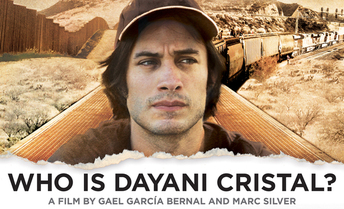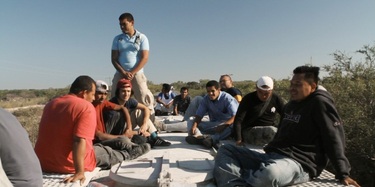
With the constant struggle between the developing world, who yearn for better opportunities and the developed world, who fear that immigration will strain their countries resources. There is no easy answer or solution on how to best handle immigration. With the documentary, Who is Dayani Cristal? director Marc Silver aims to present a personal story to the debate while trying to discover the identity of one man.
The documentary begins with the discovery of a body. The unidentified man has died while trying to illegally enter America through the Arizona desert. Despite his lack of identification the Pima County Morgue team investigating his death have one clue, a tattoo across his chest that reads ‘Dayani Cristal’. Through the work of the morgue team, a missing border crossers family and the personal journey of one man the film builds a picture of how and why people chose to cross the American border.

The film intercuts between three distinct ways of approaching the story. The first is through the Pima County Morgue Department, whose job it is to identify bodies found crossing the border. The second is through accounts from friends and family of a man who left his home to enter North America and has not returned. The final approach is through Gael Garcia Bernal, who retraces what could have been the deceased man’s root to enter America.
Each element adds a viewpoint and weight to the story. The most personal is the accounts of the friends and family. They each describe their loved ones character and the reasons he choose to leave his family behind. The accounts build a picture of a kind and loving man who left to help pay for his sons medical bills. This gives the human element to the many bodies that are discovered in the desert each year. Silver accomplishes his aim here by giving a back story to what could be conceived as just a name on a list. The audience get to know this character and like his family wonder what has become of him.
The second approach is through the Pima County Morgue team, whose job it is to identify the bodies found trying to enter America. Although this is the more technical aspect of the story the officials all show such apathy for the people who die trying to pursue a better life. The team describe their desire to return the deceased back to their homes and hopefully give grieving families peace. This approach also adds to the human factor through the team’s struggles and sympathies but also presents the audiences with statistics. Since the erection of the fence across the Mexican, United States border the number of bodies found in the desert has risen from an average twenty to two hundred per year. Silver argues that what was meant as a deterrent to those wanting to border hop into the States has merely forced desperate people to still cross the borders despite the greater risks. Sadly Silver has chosen to not challenge his viewpoint presenting this as fact
and not a side in a debate. Despite Silvers one sided approach these sections of the film are its strongest argument against the use of a border fence.

The film is presented in an overall naturalist and non-flashy style yet it displays some beautiful cinematography. The scenes of migrants travelling on top of the trains are incredible, despite their complete contrast to the desperate stories of the travellers. The film does open with brief grisly scenes as the body is found in the desert. It is a shocking opening that will capture your attention from the start.
The film adds such a personal touch to the greatly debated subject of immigration. It reminds audiences that where you are born is truly a lottery. Those who are born in developing areas of the world simple want the opportunities that others possess. The film may not offer any answers or solutions on the issues surrounding immigration but it does strongly argue that the fence system is not working. By building gates that block the easiest routes into the U.S, the Government have merely forced those crossing into more dangerously territory. The journey now means a greater risk of death to border crossers as a solution to illegal immigration.
Although the film has moral intentions it has shown its bias by refusing to either challenge its viewpoint or state its opposition. Whether you are or are not in favour of immigration the film does present a personal story that will have audiences thinking. An interesting film that argues its point well enough.

 RSS Feed
RSS Feed
